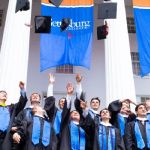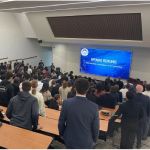

“Our culture has changed—over decades, over generations, but especially since the 1960s. We’re now more informal than we used to be, more spontaneous, more widely creative, and far more diverse,” said renowned music writer, teacher, and consultant Greg Sandow. “That’s not good for classical music, an art form that features musicians in formal dress [performing] masterworks from centuries past over and over.”
Sandow was keynote speaker at the Sunderman Conservatory of Music’s Symposium this past February, which looked for new direction amid the shifting demographics, tanking ticket sales, and disappearance of the classical canon impacting the music community today.
So when the cornerstone of music conservatories is the classical tradition, and that tradition no longer resonates with audiences as it once did, what do you do?
 Distinguished visiting panelists from the Peabody Institute, Lawrence University, and the Imani Winds alike crusaded for music education to evolve with the times. If you’re on the Sunderman faculty, you adapt. You expand the musical canon. You find new ways to connect the music and the musicians.
Distinguished visiting panelists from the Peabody Institute, Lawrence University, and the Imani Winds alike crusaded for music education to evolve with the times. If you’re on the Sunderman faculty, you adapt. You expand the musical canon. You find new ways to connect the music and the musicians.
“As in any other field, musicians must learn the fundamentals of their discipline— its history, its structure, and its application, and this includes the canon of classical music,” said Prof. Susan Hochmiller, coordinator of vocal studies and opera workshop director at Sunderman.
“But in today’s evolving musical landscape, the most successful musicians are not only excellent performers. They have also gained important critical thinking, writing, communication, and entrepreneurial skills. This is what Sunderman Conservatory students are uniquely equipped to do.”
Studying at Gettysburg College enables students to think beyond the notes, to more fully appreciate an artist’s inspirations and struggles, and to make connections across musical genres and fields of study.
In short, it’s a marriage of the music conservatory and the liberal arts.
This means expanding the curriculum beyond a European classical core of Frédéric Chopin and Johannes Brahms, and incorporating lessons on the folk- rock of Bob Dylan, the reggae of Bob Marley, and the hip-hop of Public Enemy—and, more importantly, the contemporary social and political movements their music represents.
“No kind of music is separate from its cultural background,” said Prof. Paul Austerlitz, an ethnomusicologist and Afro- Caribbean music scholar at Sunderman. “I want our students to understand music as an expression of their spirituality, of their personality, of their humanity.”
 Prof. Brent Talbot agrees. “In our music education program, social justice is the foundation for our work, and music is the medium we use to enact the change we would like to see in our world.”
Prof. Brent Talbot agrees. “In our music education program, social justice is the foundation for our work, and music is the medium we use to enact the change we would like to see in our world.”
Like Austerlitz, Talbot promotes active citizenship through the examination of songs by artists like Kendrick Lamar, Rage Against the Machine, and Woody Guthrie. He asks students to consider how these protest songs have been used and reappropriated in various historical and cultural contexts.
For example, Woody Guthrie’s “This Land is Your Land” is a scathing rebuttal to Irving Berlin’s portrayal of a Perfect Union in “God Bless America.” Yet, many of the original verses that highlighted the injustices Guthrie witnessed in his travels in the 1930s have since been eliminated from the piece we sing in schools today—leaving us with versions that are watered down.
As coordinator of music education at Sunderman, Talbot also asks his students to compose their own protest songs. The exercise encourages students to reflect upon political, racial, and socioeconomic issues; draw upon their own theoretical and musical knowledge; and ultimately team up with music and non-music majors to pull off an entertaining performance.
“I want our students to understand music as an expression of their spirituality, of their personality, of their humanity.”
—Prof. Paul Austerlitz
This interdisciplinary engagement not only leads to new passions for Sunderman students, it also empowers them to market their talents and form meaningful partnerships on campus, in the community, and abroad. In turn, it ignites a creative movement in spaces too often void of artistic expression.
“As music teachers, our job is to facilitate and make connections across disciplines. We can’t compartmentalize and teach in a vacuum. Instead, we need to bring into our musical spaces the strengths and richness found among all disciplines,” said Talbot.
But if forming connections with the outside world is the lifeblood of developing 21st-century musicians and educators of impact, it is essential students fully recognize their own musical identity.
That’s why for more than two decades, Prof. Marta Robertson has asked her students to provide the “Music of the Day” for her classes.
“Some pick a piece that features their instrument, others connect it back to the day’s topic—my students love it. It’s personal to them,” she said. “It helps to expand everyone’s musical palate, plus it gives me a way to understand who my students are and the culture that they come from.”
Robertson doesn’t expect her students to fall in love with every selection—country being a genre of particular contention— but she hopes they can begin to acknowledge their own biases and learn to more fully appreciate the music of others.
“It’s about finding belonging for all kinds of music.”
And after a decade of providing rigorous musical training, that’s where Gettysburg College’s Conservatory of Music is, too: ready to add new voices, vary its sound, and heighten its impact. And ready to take its first verse and bridge to the chorus.
“There are many motivations for creating music today. Sometimes, it’s about making a personal statement, and other times, it’s about connecting to a greater social importance, but sometimes, it’s really about creating beauty—we should never forget that,” said Kay Hoke, Sunderman Conservatory director.
“When you see the way our students are combining majors—music with physics, with psychology, with mathematics— it’s intentional. We see it more and more, a combining of passions. Our students are really thinking about shaping both a meaningful career and a fulfilling life.
“I think this makes our Conservatory a more interesting place, a better place, a place where we can learn from each other and forge connections in a deeper way, because of that diversity.”


